Alpine Herb Bitters
Western Mountain Themed Square
01 April 2012
![]() The next in the ‘Mountain’ embossed or themed Bitters is the Alpine Herb Bitters. This series was inspired by a request by Matthew Tigue Levant asking over on the facebooks Antique Bottles for Sale page, that he is “looking for any med, bitters, cure bottles with the word “Mountain” embossed in the glass”.
The next in the ‘Mountain’ embossed or themed Bitters is the Alpine Herb Bitters. This series was inspired by a request by Matthew Tigue Levant asking over on the facebooks Antique Bottles for Sale page, that he is “looking for any med, bitters, cure bottles with the word “Mountain” embossed in the glass”.
“looking for any med, bitters, cure bottles with the word “Mountain” embossed in the glass”
Previous posts (see bottom of this page) have dealt with Bitters bottles with the word ‘Mountain’ embossed directly on the bottle. The Alpine Herb Bitters is not embossed with ‘Mountain’ but research shows us, in this case, the brand is Mountain themed. I thought I would outline my steps of basic research for the Alpine Herb Bitters. Having this information in one area is very helpful. I can also update as I receive new information.
I usually first look at Carlyn Ring and W.C. Ham Bitters Bottles (I also check Bitters Bottles Supplement) and see the following:
A 37 ALPINE / HERB BITTERS // f // motif shield with monogram TT&CO // f //
10 x 2 3/4 (7 1/2) 1/4
Square, Amber, LTC, Tooled lip – Very Scarce; Applied mouth – Extremely rare
TT&CO: Thomas Taylor Company, San Francisco,
Besides the name and graphics, I am immediately drawn to the Thomas Taylor and San Francisco references telling me that this is a western square.
I first Google Alpine Herb Bitters and as expected, find little if no information. I do see a hint of a post by Kentucky Gem over on a western glass site that I will circle back too below.
Next I google Alpine, specifically in California and see that Alpine is a census-designated place (CDP) in San Diego County, California. Alpine had a population of 14,236 at the 2010 census, up from 13,143 at the 2000 census. (See Fig: 2). Not a likely link.
Following the Google search, I look at my Western Bitters book by Bill & Betty Wilson, copyright 1969, and see a nice black & white plate showing a labeled Alpine Herb Bitters and two (2) smaller photographs of the embossing of the typography and shield (see Fig: 3). The ALPEN word, German text and cross pretty much confirm the ‘Mountain’ reference and link I am looking for. [Addendum] I also see a note stating ‘1888 only’. I suspect this is incorrect.
Next I look at my The Best of the West | Antique Western Bitters Bottles by Jeff Wichmann and see a beautiful page dedicated to the ALPINE HERB BITTERS with T.T. & Co. monogram on page 27. (see Fig:4). I really like the framed advertisement on the page. This confirms the product, mountain theme and has Thomas Taylor & Company on the frame. Wow is all I can say. [Addendum] I again see the note stating ‘1888 only’ which must have been taken from the Western Bitters book and not the Bitters Bottles book.
I next add a great picture of the Alps as the header to this post. In this case it is Alpine Landscape – by George Frederick Watts. (see Fig: 1.)
For heavy duty product research, I head over on-line to Western Bitters News and Western Glob Top Whiskies | Western Glass (see Fig: 5) and look to see if anyone has written about the Alpine Herb Bitters and more specifically, Thomas Taylor. I see the following:
Thomas Taylor began his liquor career in San Francisco during the 1850’s amid the California Gold rush. Taylor was born in Hamburg, Germany in 1831. He came to California, first working in Sacramento, then in San Francisco to mine the gold of pocketbooks, which poured open as the whiskey flowed. By 1858 he had started his own wine and liquor business at 109 Clay Street. In 1861 he became a partner with John G. Frisch at 413 and 415 Clay Street in San Francisco, living at 716 Union Street. The business was known as Frisch & Co. Read about Thomas Taylor.
THOMAS TAYLOR & CO.’S ALPINE HERB BITTERS c1888 – c1896 [from Thomas Taylor Western Whiskey Tool Top Gazette – Kentucky Gem (Bruce Silva)
Sometime in the 1880’s, Taylor & Co. created Alpine Herb Bitters. The date of creation is uncertain, though Bill Wilson in his book Western Bitters, claims that Alpine Herb Bitters was only distributed in 1888. We now know that Alpine Herb Bitters was made and distributed at least during the period 1888-1896. A record of a patent for the Alpine Herb Bitters in US Patent records was not found, though it may have been under another man’s name, and therefore difficult to locate. Unfortunately, Patent records are not well indexed, adding to the difficulty in research.
There are two distinctly different embossed bottles bearing the Alpine Herb Bitters name. The earliest is a very crude amber, square, applied top bitters, of which at least four specimens are known. One of the applied-top specimens was dug in Virginia City by Vera Bennett, an early bottle digger of the 1960’s. This bottle has all the ear-marks of a bottle made well before 1888, but as yet, there is no documentary evidence of Alpine Herb Bitters before that date. One might make the assumption that the applied top Alpine bottle might have been made just after the company re-emerged in San Francisco in late 1883, but more research is needed to study that possibility. The second bottle is a very neatly made tooled top square bitters, with a nearly identical embossed pattern. There may be less than two dozen of the tooled top variety known, though there was no attempt made to inventory these bottles in collections. This bottle could easily date to the late 1880’s, but the first bottle certainly seems older based on comparative construction, though applied top bottles are known as late as 1899. Neither bottle carries a town name, indicating the possible distribution of the product in more than one city.
Taylor’s letterheads from the 1890’s reflect the marketing of Alpine Herb Bitters, and it certainly was distributed from San Francisco as late as 1896. No records were found from Taylor’s Virginia City operation that could place distribution of the early applied top Alpine Herb Bitters in Virginia City, though this still remains a possibility. Several other western bitters are also found in both applied and tooled tops, an indication of manufacture throughout the 1880’s and 1890’s at least. These include: Hibernia, Pipifax, Dr. Thos. Hall’s, Jewell, Louis Tausig, Excellsior, Booth, and Dodge & Co.
The Alpine Herb Bitters name and recipe was probably sold or leased to other companies for distribution, particularly after 1901. An amber, round neatly made bottle with an Alpine Herb Bitters label shows the agent as N. Van Bergen, and another neatly made, post-1906 paper labeled bottle shows Wichman-Lutgen as the agents.
Without more information on the recipe, it is difficult to ascertain the contents. Many would like to know which alpine herbs were used, and from what part of the Sierra Nevada they came, the only alpine environment around. More research may solve these mysteries.
There are at least three other embossed bitters bottles bearing similar names. Swiss Alpine Bitters , Swiss Alp Bitters (2 varieties) and Hungerbuehler’s Swiss Alpine Bitters. Any relationship between these and Taylor’s Alpine Herb Bitters is unknown and deserves more research.
I then google Thomas Taylor again and look deeper to find a shot glass with his name on it. (see Fig: 6)
(Fig: 6) Shot Glass – TRADE MARK (slanted down/up beneath a frosted shield upon which is etched a head and shoulders portrait of a bearded man, facing left) / TOM TAYLOR (arched) / (line of three large stars) / EXTRA PONY / WHISKY. (enclosed within a rectangular outline) / THOMAS TAYLOR & CO. / SAN FRANCISCO / EST 1858 (arched)
I next try to figure out if the Alpine Herb Bitters was made at Pacific Glass Works, San Francisco Glass Works or Pacific Coast Glass Works. A quick email to western glass authority Warren Friedrich gets the following reply:
“If you are talking about the square bitters with the monogram/shield embossed on the one panel and the words ALPINE HERB BITTERS on another panel it was not (made at Pacific Coast Glass Works). That was most likely manufactured by S.F.& P.G.W. That bottle is much earlier than when P.C.G.W was in operation”. Warren
I’ve posted a few pictures (see Figs: 7, 8 & 9) of my example below with does not have an applied top. This was won at Pacific Glass Auctions (now American Bottle Auctions), Auction 30 and was Lot #166 back in 2003. This applied top example is very much something I am looking for.
Read more on ‘Mountain’ embossed or themed bitters. All prompted by a request by Matthew Tigue Levant asking over on the facebooks Antique Bottles for Sale page, that he is “looking for any med, bitters, cure bottles with the word “Mountain” embossed in the glass”.
Dr. Black’s Rocky Mountain Bitters

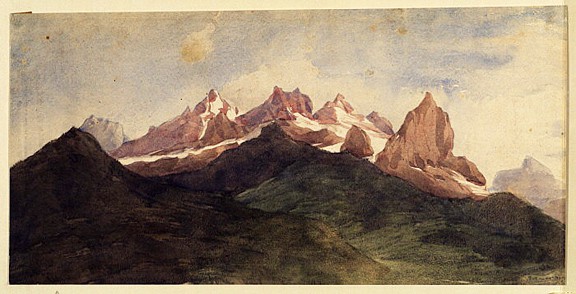
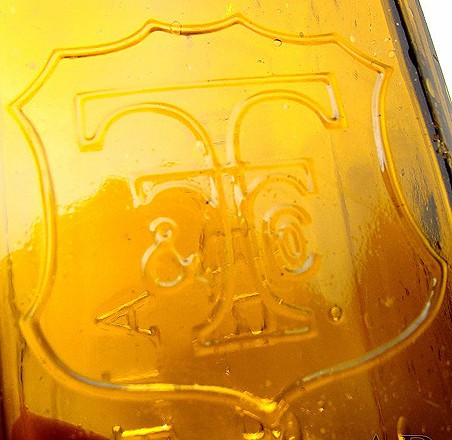
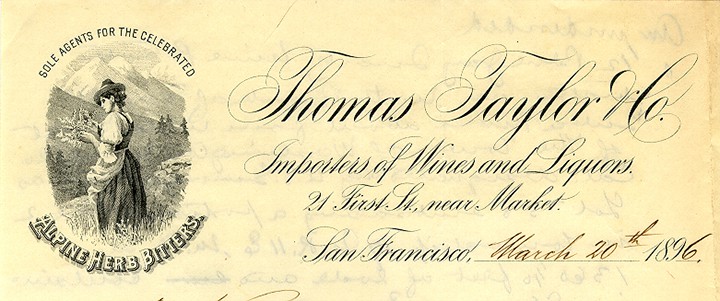
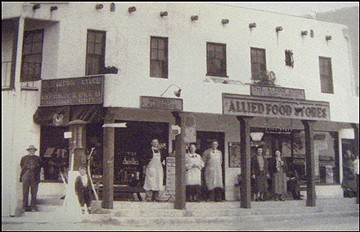
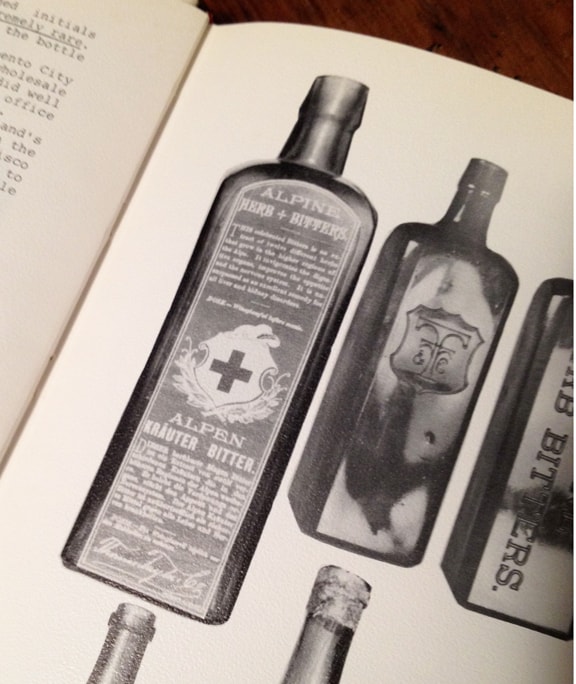
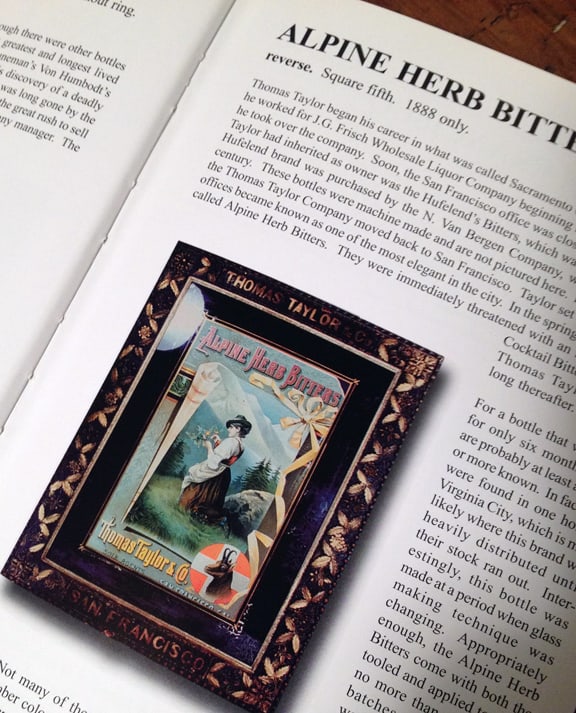
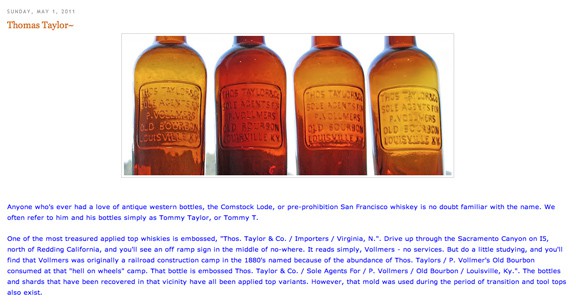
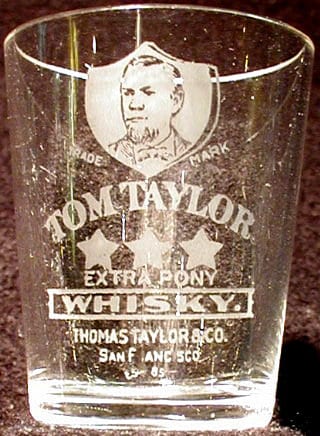
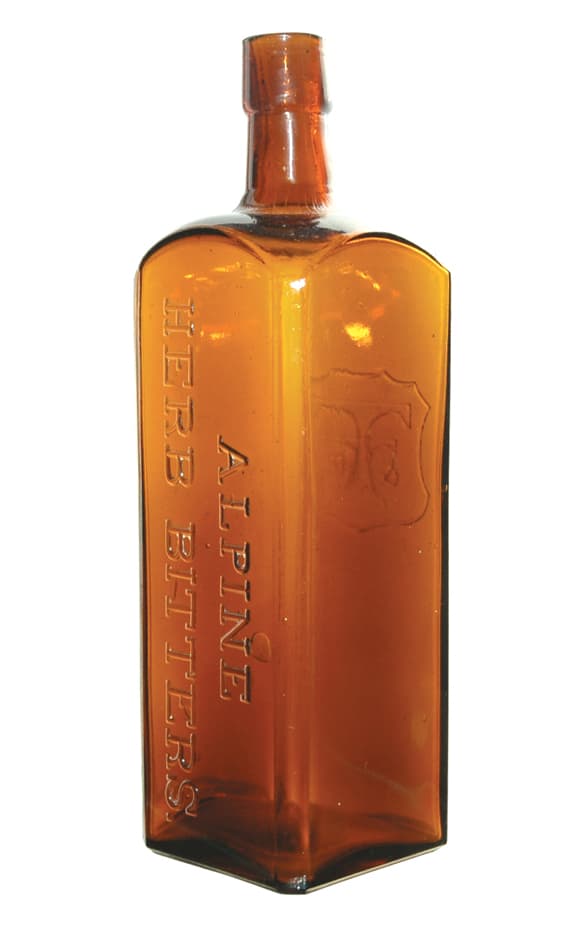
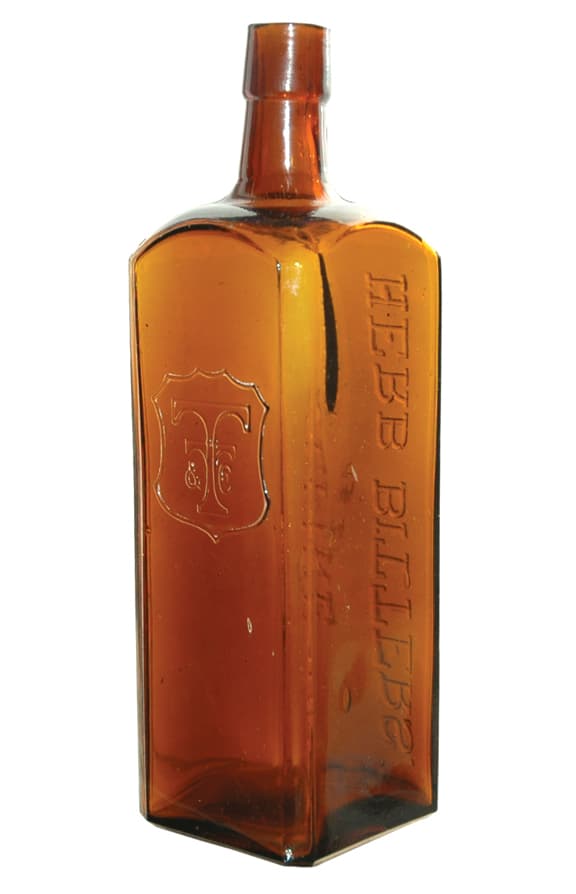
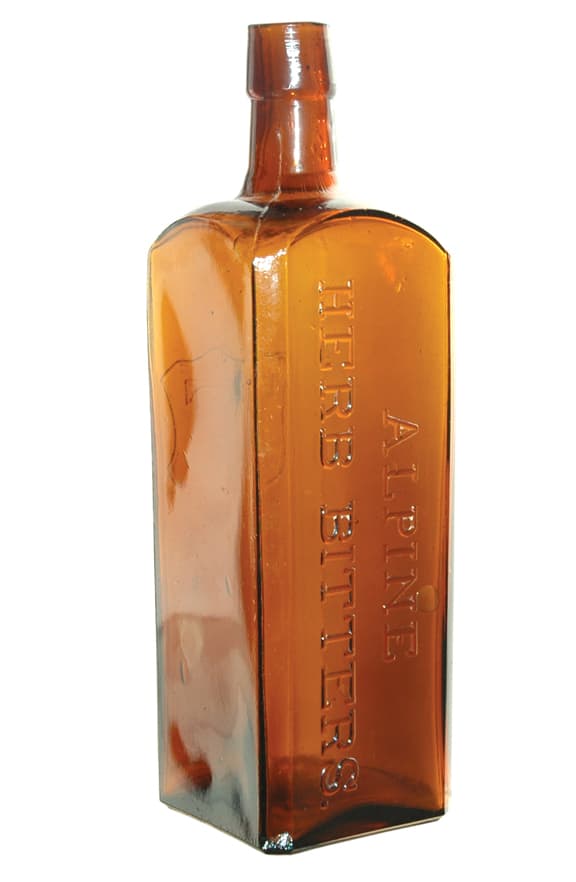
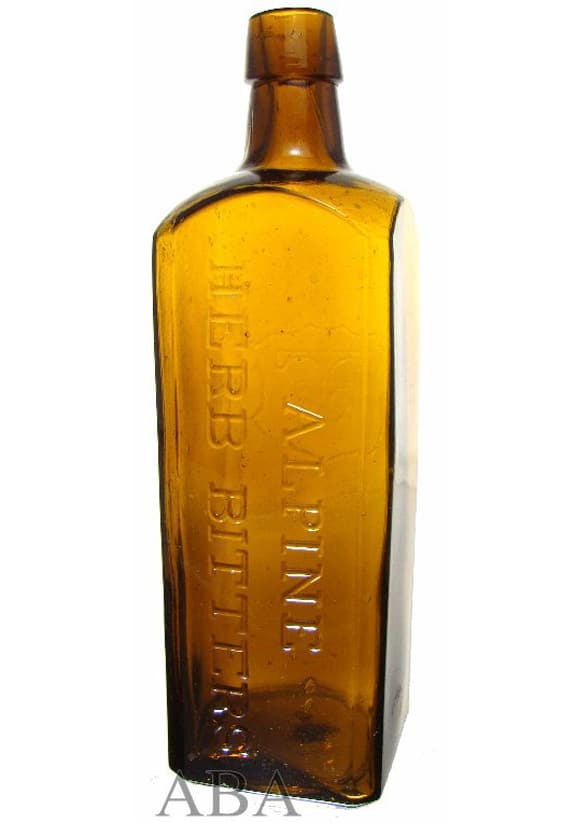
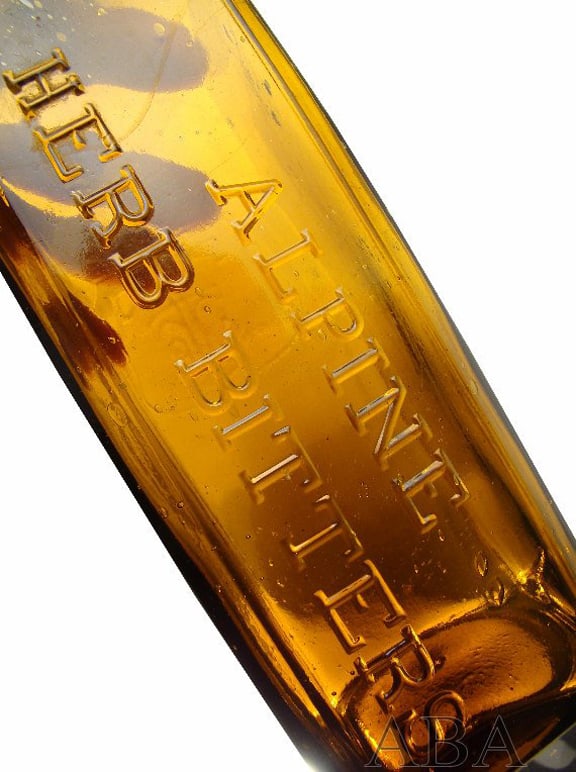
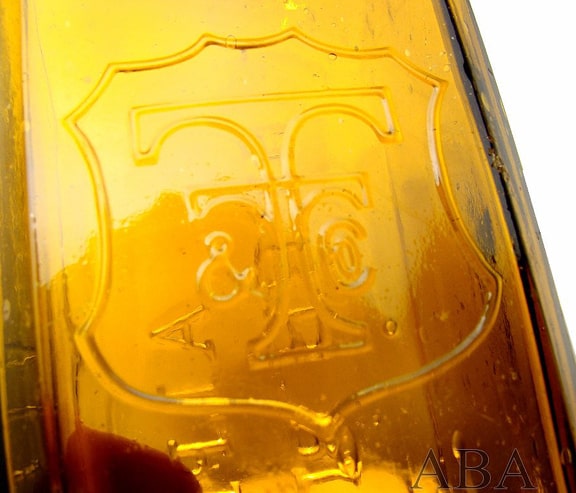
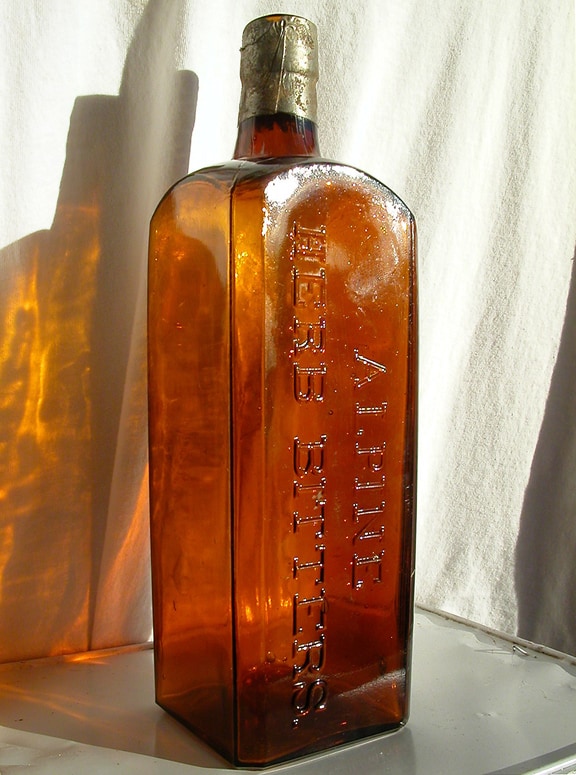






I sold both my Alpine bottles and sign to a collector who now resides in Colorado. The advertisement is a striking piece.
Applied Top or Tooled? Any pictures of that sign? Was it the one in Bitters Bottles on page 60?
Yes, exactly the same, but not that particular example. Bottles were one applied, the other tooled. Very crude and great colors.
[follow-up email from Bruce Silva]
Ferd:
One of the bottles that I parted with when I liquidated my western bitters collection back in the 80’s was an absolute to die for applied top example of an Alpine Herb. I remember it like I’m still holding it in hand. It was that impressive.Absolute killer strike. Whomever applied the tapered collar though, closure flunked bottle production 101. The glop and subsequent attempt at cleaning up the mess was amazing. The bottom edged of the top wandered up and down with a variation approaching 1/2″; none of it even or smooth. Just a gobbed up mess. And the body had more froth bubbles than glass. Picture your six year old pounding that bottle of Sierra Nevada porter up and down on the counter just before you pop the cap. Imagine what erupted from the bottle and into your glass. That’s what the bottle looked like.
I first saw it on display at the Reno show in the early to mid seventies. An old guy that looked, dressed (and smelled) like he’d just gotten off of a prospecting burro was the owner. I dogged him for two year before finally acquiring it. Paid him $85 cash. I kept it for several years and sold it for a little over $100. That was the same day I sold my Dr. Millers Ratafia Damiana for the princely sum of $140. Funny, thirty some years later and I’m still kicking myself in the ass for both of those genius moves. Old too soon, smart too late. Bruce
PS: and no, I don’t recall who bought it. I looked in my notes. Was hoping to hand you a lead you could run with.
Bruce… Just reading your story is great. Thanks for sharing. F
[follow-up email from Bill Ham]
Ferdinand:
The “1888 only” attribution for Alpine Herb Bitters is not mine, and I
do not agree with it. Look at the letterhead above the listing in
BITTERS BOTTLES and you will see that the ALPINE HERB BITTERS, TT&CO
letterhead is dated March 20, 1896.
Bill Ham
Thanks Bill. You are 100% correct. The ‘Made in 1888 Only’ note looks like it appeared in the Wilson book first and than the Wichmann book. It is not noted that way in Bitters Bottles and I amended the post in a few areas above. It is obvious that the period is much wider with the applied tops, tooled tops and the letterhead on Page 61 in Bitters Bottles. The Silva notes also confirm the 1880’s and 1890’s at least. F
Most likely 1886/7 to early to mid-1890s for the embossed bottles. Paper labeled later on. I will go to the CA State Archives and confirm TM dates.
[from western collector Richard Siri]
The sign Mike sold he got from me. The sign pictured in Jeff’s book is hanging in my bedroom. I also have both types of the bottle.
When you look at Jeff’s book, only the picture on page 67 and the small clipped ad on page 114 are not mine. All the rest of the advertising signs, letterheads and trade cards are in my collection.
RTS
John Conrad Hungerbuehler, of Hungerbuehler’s Swiss Alpine Bitters, was my great-great-grandfather. He emigrated from Switzerland in the 1850s and settled in Philadelphia. I know that he was at one time a dealer in hog bristles, and that he became an importer of wines and brandies, and then dealt in the celebrated Swiss Alpine Bitters. Family folklore said that the formula was heavy on alcohol and laudanum. After he died, the folklore continues, his son studied to become a doctor, burned the formula, and worked for some years in an opium clinic as penance. I can’t speak to the truth of the folklore, but I can supply a photo of an advertising poster for the stuff and would be thrilled with a photo of a bottle in exchange.
Wow, very interesting and good information. Let me look for a picture and more information on this brand. Thanks.